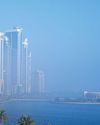Essayer OR - Gratuit
WAY TO WATER RESILIENCE IN THE MIDDLE EAST
Gulf News
|October 13, 2025
Innovation and regional coordination are key to tackling a challenge that affects every community

The Middle East is experiencing several overlapping crises. Among the ongoing wars and conflicts, water scarcity holds an important place in the region's equations. The Middle East faces a future where water and food security are increasingly under threat, with per capita availability of fresh water falling below the UN's water poverty threshold of 1,000 cubic metres per person per year. There are also uncertainties about the availability of sufficient quantity and quality of fresh water to sustain livelihoods without negatively impacting people, the environment, and economies.
The entire world is affected by water scarcity to varying degrees. More than one billion people live in areas suffering from water scarcity, and 1.6 billion people face water shortages. However, the Middle East and North Africa are among the regions most severely affected by the water crisis.
According to the United Nations (2023), around 50 million people in the Arab region lack access to basic drinking water, and 390 million people (90 per cent of the total Arab population) suffer from water scarcity.
Natural limits, human impact
Water scarcity is a natural phenomenon exacerbated by human intervention. Fresh water on Earth is sufficient for more than 8 billion people (the global population), but it is unevenly distributed across geography and demography.
Cette histoire est tirée de l'édition October 13, 2025 de Gulf News.
Abonnez-vous à Magzter GOLD pour accéder à des milliers d'histoires premium sélectionnées et à plus de 9 000 magazines et journaux.
Déjà abonné ? Se connecter
PLUS D'HISTOIRES DE Gulf News

Gulf News
Life Healthcare Group, CJ Olive Young sign strategic agreement
Collaboration positions UAE as a regional hub for Korean beauty innovation
2 mins
November 21, 2025

Gulf News
Beach tragedy claims 2 Pakistani boys' lives
Father recounts final moments after son, friend drown in Ras Al Khaimah beach
1 mins
November 21, 2025

Gulf News
Indian gets $40K cheque for 40-year service
Balbir Singh was feted for his long years at a McDonald’s franchise
1 min
November 21, 2025
Gulf News
Iran's President looks to shift capital from Tehran
Reasons include overcrowding and a water crisis
1 min
November 21, 2025
Gulf News
Nitish Kumar takes oath as Bihar CM for record 10th time
Opposition urges new NDA government to fulfil its promises
1 mins
November 21, 2025

Gulf News
Souleymane: I rely on inspiration — the legacy I want to leave
Dubai's triathlete completed 100 triathlons in 100 days
2 mins
November 21, 2025
Gulf News
NIA arrests 4 more in Red Fort blast case
NEW DELHI
1 mins
November 21, 2025
Gulf News
Can a property buyer recover unpaid fees from previous owner?
Ask the law
1 min
November 21, 2025

Gulf News
MONSTER FOG ENVELOPS UAE
Visibility plunge causes red alerts, as police cut highway speed caps, flights divert
1 min
November 21, 2025
Gulf News
Dubai gold price cooling again after a wild start to month
UAE retail prices continue to track global sentiment
1 mins
November 21, 2025
Listen
Translate
Change font size

